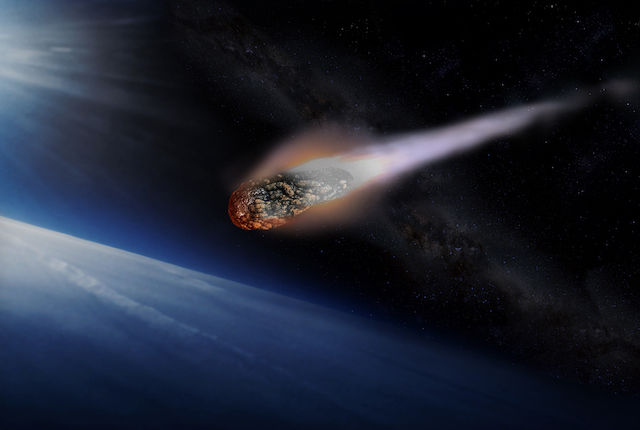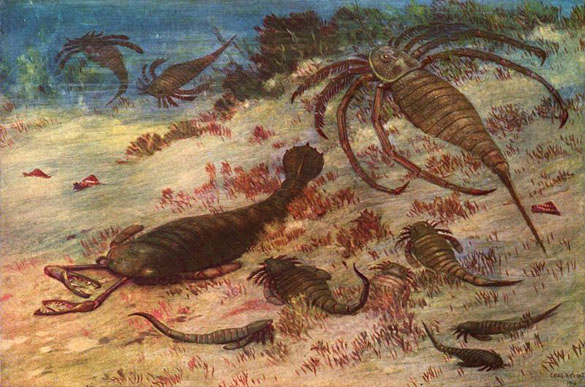The entire early history of the Earth itself is one of extreme violence – a series of extreme catastrophic accidents that ultimately shaped it into the habitable form it is today – collisions, volcanoes, earthquakes. Even when the Earth was a habitable place, thriving with life, it was unsafe from mass extinction events, which took place roughly every 50 million years or so. To date, scientists describe a “big five” list of these incredible events, the last one wiping out the last of the non-avian dinosaurs 65 million years ago. While it is sometimes argued that the rapid disappearance of species in the present day is the sixth major extinction event, there actually may have already been one that was considerably overlooked in our distant past.
Today, paleontologists argue that this sixth major extinction event took place 260 million years ago, towards the end of a geological age known as the Capitanian, which predated the major Permian-Triassic extinction event by only about eight million years. A recent study offers up the evidence that there was a massive die-off during this age in the shallow, cool waters near what currently make up modern day Norway. This new discovery, along with the combined earlier evidence of extinctions taking place in tropical waters, suggests that the Capitanian event was a catastrophe of global magnitude.
“It’s the first time we can say this is a true global extinction,” said David Bond, a paleontologist from the University of Hull in the United Kingdom. Bond recently led an international team in a study that has been published online this week through the Geological Society of America Bulletin. As overlooked as it has been, Bond maintains that in its magnitude, this Capitanian event was actually on par with the dinosaur-killing extinction that took place 65 million years ago. “I’d put this up there with it, albeit with slightly less attractive victims,” Bond says.
Not a whole lot of people are aware that the dinosaurs existed in a number of forms, over three different eras (the Triassic, Jurassic, and Cretaceous) with some minor extinction events in between, let alone the Capitanian era. Actual scientific interest in this age first began during the early 1990s, during which paleontologists discovered the evidence for fossil extinctions happening in rock formations across China. These rocks had originally formed on the floor of what was once a shallow tropical sea. Most foraminifera — which are tiny, shelled protozoans, only slightly larger than bacteria — had died out, alongside numerous species of the clamlike brachiopods, which make up some of the most commonly found fossils – shell impressions that can be found near most modern streams.
There is also evidence of a potential trigger to blame for the gradual chain of destruction: a series of ancient volcanic outbursts in China. Afterwards, these volcanoes would congeal into a rock formation known as the Emeishan Traps in southwest China’s Sichuan Province. The hot flowing basalt would give off massive amounts of sulfur and carbon dioxide, which was released into the air, potentially leading to a sudden global chill. The brief cooling period would then be followed by a substantially longer period of global warming. The release of carbon dioxide would have also led to intensified ocean acidification, along with oxygen depletion in the water. Ocean acidification later played a role in the Permian-Triassic event, which only took about 60,000 years to obliterate most species on Earth, and was by far the most deadly that the Earth has ever experienced. Many scientists suspect that a similar massive burst of volcanic activity as the one in Emeishan Falls took place in Siberia, setting off a chain reaction of events that would wipe out over 90 percent of life on Earth.
So why has the Capitanian extinction so overlooked? Little is known, and many have suggested that it was a regional event, or that it may have in fact been just an isolated disaster, a symptom of the trends that would eventually culminate in the much larger Permian extinction. It was only officially recognized as an individual era within the Permian Age in 2001 on the international timescale used by geologists. The newly discovered evidence may dispel some of these reservations about the era. One such piece of the puzzle comes out of Spitsbergen, which is the largest island of the Svalbard archipelago, just off the coast of Norway in the Arctic Ocean. It is there that Bond and his colleagues did an examination of chert rocks. These rocks are the result of silica buildup, a volcanic byproduct which has been produced out of the skeletons from dead sponges. The chert may also contain several species of extinct brachiopods. At the time of the Capitanian event, these rocks would have begun forming within tens of meters of cooler water at midlatitudes. But here it’s not so much what the rocks contain that’s interesting, as what isn’t there. There was a point recorded the rock record when these fossils suddenly disappeared.
“They all drop out,” says study co-author Paul Wignall, who is a paleontologist at the University of Leeds in the United Kingdom. “It’s like a blackout zone and there’s nothing around.” At some point a little further along in the rock record, several of the brachiopod species recovered, according to Wignall. Afterwards, the mollusks begin to take over in sizable numbers, thriving right up until the devastation of the Permian extinction begins, another eight million years after. Right now, the ocean acidification due to anthropogenic climate change is reducing pH levels in the ocean water, affecting numerous species that have evolved at specific pH levels and bleaching coral reefs, a pattern that will disrupt a number of marine ecosystems across the planet. Perhaps 260 million years ago, the situation was not too different. There’s been some even more unsettling news – the discovery of shellfish cooked by the increasing acidity, as the ocean tries to act as a carbon sink, absorbing the record levels of carbon dioxide released into the air.
The research team has actually had a difficult time attributing the latest record to the same moment documented by fossil records throughout China. Isotopic dating systems are too uncertain to provide the researchers with a helpful absolute date. Another standard method of dating – biostratigraphy, which links the timing between the different rock layers by the nature of the fossils they contain. In this instance, it’s the appearance and disappearance of fossilized teeth from small tiny eel-like creatures known as conodonts. However, these also couldn’t be used, because the population had diverged, and different species lived in cool waters from those living in tropical waters. Instead, the team has had to rely on a pattern of similar swings at the levels of different isotopes, something that occurs in both parts of the world where the evidence was found, implying that both Scandinavia and Asia had both experienced alterations in oceanic chemistry around the same time.
The imprecise dating may actually be a part of the problem, according to Matthew Clapham, who works as a paleontologist at the University of California, Santa Cruz. He did not participate in the study but thinks that the events dated by the study team may have actually taken place a bit more recently — happening only about 255 million years ago. “They’ve definitely identified a real event, which is really interesting,” he agrees. “Their age model is less convincing.” He also put their discovery in perspective of some recent work in China, which suggests that the full extent of the Capitanian extinction and its effect on different species may actually tell the opposite story – suggesting that it was not nearly as bad as many paleontologists had originally thought. When it comes to listing extinctions, Clapham thinks that the Capitanian is probably 30th or 40th on the hierarchy but certainly not the sixth. Rather, the new discoveries may have been a symptom of the impending Permian mass extinction.
Bond, however, remains convinced that perhaps one day science books will list the Capitanian as one of the worst extinction events in history. “You have to change a lot of people’s minds,” he said. Right now, he is studying the fossil records of Russia and Greenland that may further support his case that the Capitanian was a global disaster. Clapham, too, would like to see a greater understanding of what was largely an enigmatic stretch in the history of our planet. “It’s a very mysterious event—it’s an interesting thing to study,” he says.
|
James Sullivan
James Sullivan is the assistant editor of Brain World Magazine and a contributor to Truth Is Cool and OMNI Reboot. He can usually be found on TVTropes or RationalWiki when not exploiting life and science stories for another blog article. |





